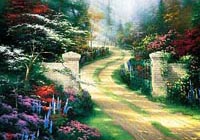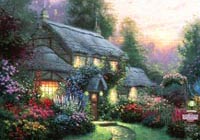
Thomas Kinkade, Hidden Cottage
|
The paintings (and reproductions) of Thomas Kinkade are the most widely collected
of any living artist. His legions of fans run the gamut from homemakers to working
husbands to grandmothers all across the country. Kinkade's work has appeared on
Hallmark greeting cards and countless
calendars.
He has even authored
several
books. No other artist currently alive has had such a dramatic impact as he.
Born and raised in California, Kinkade showed an aptitude for art early on.
His upbringing in a small American town set the stage for his later blossoming
as the voice of reason arguing for a return to the simpler pleasures of a quiet,
domestic life. Like all great artists, his journey towards artistic enlightenment
was a bit rough and tumble, and he ventured across this great land of ours on
box cars in search of the vision that would guide him through his later life.
Eventually Kinkade found his voice through scripture, and he has been preaching
his message through painting ever since.
[According to some], the concept that an artist would be revered by popular
culture is an immediate dismissal of his relevance as an artist. To my mind,
the art of the elite is the irrelevant art. To my mind, no matter how much
the New York critical establishment tells me Robert Rauschenberg is an important
artist, his Q rating is zero. No one knows who he is.
Thomas
Kinkade
Indeed, we live in sad times when quality judgments are only allowed by a handful
of "professionals"
who's sole qualification to judge is that they have spent a great deal of time
around art. Since when does it require a college
degree to decide what is attractive? What gives these people the gall to
believe that they are uniquely suited to these tasks? It does not take a lifetime
of study to appreciate beauty, and in fact the obsession of these people has
led them away from true art, not closer to it. Time and again our schools
and and culture have been shown to ruin the minds of those who study too deeply,
filling their heads with contempt for their pedestrian roots.

Thomas Kinkade, Spring Gate |
The art world was hijacked by a group of self-styled "elite"
artists
in the early 20th century in Paris, and we have been struggling under the weight
of this oppression for almost 100 years. Art is quite simply a manner of conveying
beauty and serenity to as large a number of people as possible. Any higher aim
of art should be restricted to the realm of the spiritual awakening. Sadly, the
20th century was dominated by
those who felt
that art should serve a darker purpose. Not content with elevating mankind,
these new practitioners chose to saddle the field with explorations of
bestial
tendencies and
political
dogma. Art was ripped from the hands of the people and made to serve
a
new master. No longer was it acceptable for a simple person to derive simple
pleasure from a painting. The entire idea of beauty being in
the eye of the beholder
was cast aside, and it became necessary to "study" something that previously was
accessible to even the most unlearned cattle farmer.
The work of Thomas Kinkade is changing all of this. It should again be reiterated
that amongst every day people, no other painter's work is more collected and disseminated
than that of Kinkade. His renderings draw from a deep well of spirituality, suggesting
the peace and perfection of the simpler life. The essential concept that a work
of art should be enjoyed on a purely superficial level is resurging in society,
and we are slowly casting off the idea that a visual medium has anything to convey
to us other than visceral pleasure.
Kinkade's paintings often bring to mind those of Norman
Rockwell, that other chronicler of rose-tinted Americana. Where the great
difference lies, however, is that Rockwell was expressing a view of the times
in which he lived, fearing to venture into the realm of wistful daydreaming.
Further, Rockwell was also tainted by the mid-century art movement, and he occasionally
fell victim to the fallacy that an
image can speak of harsh reality rather than just offering an impractical
ideal to strive towards. Kinkade has had the strength to resist these temptations,
however, and has always kept the subject matter of his compositions firmly fixed
in simplistic ideals and a view of the past as it should have been, rather than
the way it actually existed. In doing this he provides an avenue of hope and
a window to a better life for those stuck in mundane reality.

Thomas Kinkade, Julianne's Cottage
|
The reasons why paintings such as those shown here are so loved can be explained
in part by their power to evoke a reaction in a manner so formulaic that one wonders
why other so-called "artists" have failed to achieve the popularity of Kinkade.
That is only part of the story, though. In addition to his formidable skill, Kinkade
also wisely understands that today's fast moving, global culture requires other
efforts to make one's voice be heard. To this aim, all of his work is expertly
disseminated by
a highly competent
marketing agency, thereby ensuring that his genius is available to all. Further,
in order to meet insatiable demand, Kinkade has chosen to push his talents to
the absolute limit by producing approximately 2 dozen works suitable for his fans
each year, while still finding time to publish his books and grant interviews!
I know of no other living artist willing to make that sort of sacrifice for their
fans, and in fact if you compare the output of Kinkade to any of the
hacks
worshipped by the high-society "art aficionados", you will see that those other
"artistes" simply don't have what it takes to generate a masterpiece every two
weeks like Kinkade does.
As for other painters
who are not popular household names like Kinkade, the reason they
will never achieve wealth and fame is because they have willingly turned their
backs on all that is good in humanity. They were tempted from the path of righteousness,
and it shows quite plainly in their
work. The road to salvation lies with embracement of the status quo and
catering to the simple wants of people through the established market. Thomas
Kinkade - painter, father and Christian - has not only shown us that road, he
has made it available to us in abundance via posters, reproductions, and even
limited edition signed prints in the frame style of our choice.
Thank you, Thomas Kinkade.

